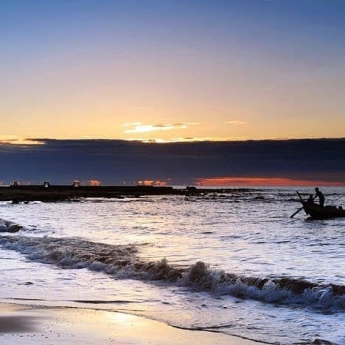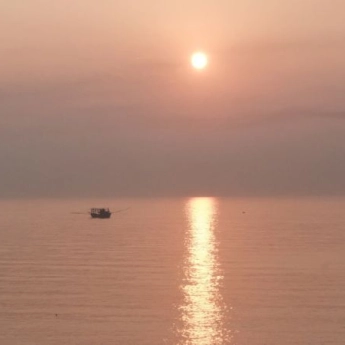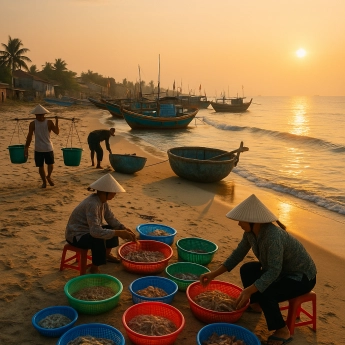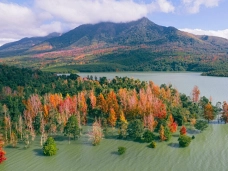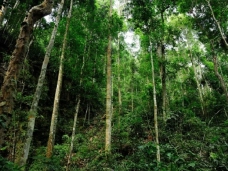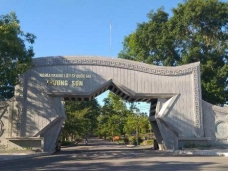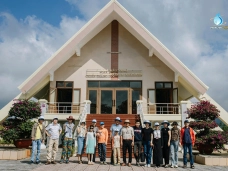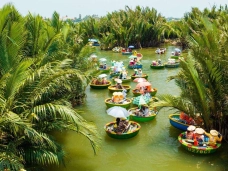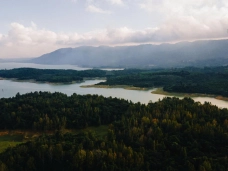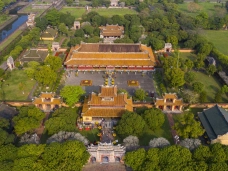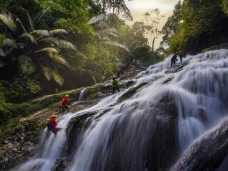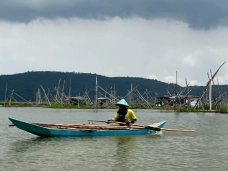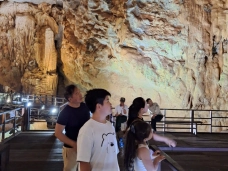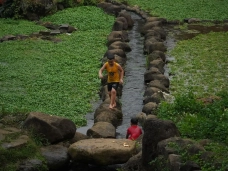Cua Tung – A Gentle Harmony of Nature and Culture
28-04-2025 06:00
Main contents
Location
Highlight Image
Overview
Nestled in the heart of Cua Tung town, Vinh Linh District, Quang Tri Province, lies one of Central Vietnam’s most enchanting coastal treasures: Cua Tung Beach. Once celebrated by international travelers as the “Queen of Beaches,” this gentle curve of shoreline captures not only the eye but also the soul, with its unspoiled natural beauty and deep historical resonance.
At the confluence where the Ben Hai River meets the East Sea, Cua Tung is located just 10 kilometers from the Hien Luong Bridge and about 30 to 35 kilometers from Dong Ha City. With a modest area of 10.47 square kilometers and a population of around 8,336 (as of 2018), the town is a cultural, economic, and tourism center for Vinh Linh District – and a vital part of Quang Tri’s identity.
Natural Beauty of Cua Tung
Cua Tung’s allure lies in its harmony of sea, river, and red basalt hills. The beach, stretching close to one kilometer through An Duc hamlet, Vinh Quang commune, is embraced by the lush green casuarina groves and the basaltic ridge known locally as Bai Lay.
-
Powdery White Sands: The sand here is fine and level, delightfully soft beneath one’s feet.
-
Shifting Hues of the Sea: As the sun arcs through the sky, the sea transforms—pink at dawn, azure by noon, and emerald by dusk—an ever-changing canvas painted by nature’s hand.
-
A Peaceful Cove: Shielded by basalt hills, the beach is largely spared from storms, making its waters calm and ideal for swimming and relaxation.
-
Rich Coastal Ecosystem: Cua Tung is home to thriving fishing villages, seaweed beds harvested in October, and the whispering shelter of pine trees—each a living part of the region’s character.
Rú Lịnh – The Green Heart of the Land
Just six kilometers northwest of Cua Tung lies Rú Lịnh, an ancient forest often referred to as the "green lung" of Eastern Vinh Linh. Spanning about 100 hectares, this tropical evergreen forest, situated at an elevation of 94 meters, boasts over 200 species of flora across 72 families, including rare woods like ironwood (Erythrophloeum fordii), Sindora tonkinensis, and the aromatic Aquilaria crassna. The forest’s name derives from the Lịnh Nước tree—a bamboo-like plant that stores drinkable water within.
Rú Lịnh also shelters 73 animal species, including birds like herons, owls, bulbuls, and starlings, and mammals such as pangolins, porcupines, and civets. Before 1945, even tigers and leopards roamed these woods. This vital ecosystem provides irrigation to nearby communes and serves as a climate regulator and biodiversity reservoir.
Yet today, both Cua Tung and Rú Lịnh face mounting pressures from erosion and unsustainable development. The preservation of their natural and cultural integrity is not only a necessity—it is a responsibility.
A Land Etched in History
Prehistoric and Feudal Eras
Archaeological finds suggest human presence in Cua Tung since the Neolithic Age. From the 11th to the 19th century, it was a vibrant trading port, bridging commerce between the Southern Kingdom (Đàng Trong) and neighboring lands.
In the 16th-century chronicle Ô Châu Cận Lục, historian Duong Van An referred to Cua Tung (then called the Minh Linh Estuary) as a military stronghold. Likewise, 18th-century scholar Le Quy Don in Phu Bien Tap Luc described its strategic importance, noting its proximity to key natural landmarks and military outposts.
French Colonial Era
During the colonial period, Cua Tung transformed into a prestigious retreat for French officials and Vietnamese royalty. In 1896, the French Résident Supérieur of Central Vietnam built the Thừa Lương House, which later became the summer residence of Emperor Duy Tân. Alongside Gothic villas, diving platforms, and stone benches, these architectural remnants whisper tales of a refined past.
Léopold Cadière, in his early 20th-century work Mission de Hué, described Cua Tung’s silk industry with admiration:
“They spin cotton and weave a coarse fabric, unique to Quang Tri. But they also cultivate mulberry, raise silkworms, and weave fine silks that are in demand both domestically and abroad. Even former Emperor Bảo Đại and his consort visited their workshops...”
Vietnam War Era (1954–1975)
Situated near the 17th parallel, Cua Tung witnessed the tragedies and triumphs of a divided Vietnam. Fierce battles raged in nearby Cua Viet (1973), and the echoes of resilience live on in the Vinh Moc Tunnels and Hien Luong Bridge—solemn symbols of national endurance and unity.
Cua Tung Today – A Living Tapestry of Growth
-
Tourism: From April to August, the beach draws thousands of visitors. Activities like swimming, beach camping at Mui Treo, and savoring local seafood (shrimp, squid, clams, snails) have become vital income sources for residents.
-
Cultural Heritage: Landmarks like the Thừa Lương House and nearby historical sites form a captivating circuit of cultural exploration. Ecotourism is also on the rise, as travelers seek tranquil escapes in the forest of Rú Lịnh.
-
Fisheries and Handicrafts: Fishing remains central to the local economy, as does silk weaving and traditional woodworking, particularly in the nearby craft village of Cat Son.
-
Maritime Trade and Economic Potential: Cua Tung’s location at the river-sea junction positions it as a promising hub for port and logistics development, with high-end resort projects now seeking investment.
-
Culture and Education: The beach’s legacy is honored in primary school textbooks and celebrated in community events, such as the Vietnam Fatherland Front's anniversaries, fostering a sense of pride and continuity.
Conclusion
Cua Tung is not merely a destination—it is a narrative carved by waves and wars, sunrises and centuries. Once hailed as the “Queen of Beaches” by the French, its sands still hold the footprints of emperors and poets, of fishermen and freedom fighters.
Today, visitors find more than a picturesque seascape. They encounter a living history, a sanctuary of biodiversity, and a community rooted in resilience. As Quang Tri strides into the future, Cua Tung stands poised—timeless and inviting, a place where nature meets memory, and the past inspires tomorrow.
Phong Nha Viet
References
- Tạp chí Kinh tế Sài Gòn. (n.d.). Cửa Tùng - nét duyên vùng biển Quảng Trị. Truy cập từ: https://www.thesaigontimes.vn/
- https://phongnhaexplorer.com/
- Wikipedia tiếng Việt. (2023). Cửa Tùng (thị trấn). Truy cập từ: https://vi.wikipedia.org/wiki/C%E1%BB%ADa_T%C3%B9ng
- VNTRIP. (n.d.). 15 địa điểm du lịch Quảng Trị. Truy cập từ: https://vntrip.vn/
- Tạp chí Thủy sản Việt Nam. (n.d.). Cửa Tùng - Nữ hoàng của các bãi tắm. Truy cập từ: https://thuysanvietnam.com.vn/
- Quảng Bình Travel. (n.d.). Top 12 địa điểm du lịch Quảng Trị. Truy cập từ: https://quangbinhtravel.vn/
- IPA Quảng Trị. (n.d.). Rú Lịnh - Lá phổi xanh của Đông Vĩnh Linh. Truy cập từ: https://ipa.quangtri.gov.vn/
- Báo Sài Gòn Giải Phóng. (2020). Rú Lịnh - Khu rừng nguyên sinh độc đáo ở Quảng Trị. Truy cập từ: https://sggp.org.vn/
- Quangtri.tintuc.vn. (2023). Khu du lịch sinh thái Rú Lịnh: Tiềm năng và thách thức. Truy cập từ: https://quangtri.tintuc.vn/
- Luật Minh Khuê. (n.d.). Thuyết minh về Cửa Tùng. Truy cập từ: https://luatminhkhue.vn/
- Thanh Niên. (n.d.). Cửa Tùng - Cảng thị sầm uất thời phong kiến. Truy cập từ: https://thanhnien.vn/
- Dương Văn An. (1553). Ô Châu Cận Lục. (Bản dịch hiện đại, Nhà xuất bản Văn hóa - Thông tin, 2001).
- Lê Quý Đôn. (1776). Phủ Biên Tạp Lục. (Bản dịch hiện đại, Nhà xuất bản Khoa học Xã hội, 2007).
- Báo Quảng Trị. (2019). Nhà Thừa Lương Cửa Tùng - Di tích lịch sử thời Pháp thuộc. Truy cập từ: https://baoquangtri.vn/
- Cadière, L. (1920). Mission de Huế. Bulletin des Amis du Vieux Hué.
- Tqlcvn.org. (n.d.). Cửa Việt: Một chiến thắng vẻ vang và ngậm ngùi. Truy cập từ: https://tqlcvn.org/



